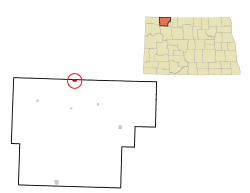Portal, North Dakota facts for kids
Quick facts for kids
Portal
|
|
|---|---|

Building in Portal
|
|

Location of Portal, North Dakota
|
|
| Country | United States |
| State | North Dakota |
| County | Burke |
| Founded | 1893 |
| Area | |
| • Total | 0.68 sq mi (1.75 km2) |
| • Land | 0.67 sq mi (1.73 km2) |
| • Water | 0.01 sq mi (0.02 km2) |
| Elevation | 1,955 ft (596 m) |
| Population
(2020)
|
|
| • Total | 125 |
| • Estimate
(2022)
|
120 |
| • Density | 187.13/sq mi (72.24/km2) |
| Time zone | UTC-6 (Central (CST)) |
| • Summer (DST) | UTC-5 (CDT) |
| ZIP code |
58772
|
| Area code(s) | 701 |
| FIPS code | 38-63740 |
| GNIS feature ID | 1036226 |
Portal is a small city in Burke County, North Dakota, United States. It was founded in 1893. In 2020, about 125 people lived there.
Portal is special because it sits right on the Canada–United States border. It's a very important spot for people and goods to cross between the two countries. Roads like US Route 52 and Saskatchewan Highway 39 connect here. Trains also use this crossing. Just across the border in Canada is a town called North Portal, Saskatchewan. Portal is one of only three places in North Dakota where you can cross the border 24 hours a day, all year long.
City Geography
Portal covers a total area of about 1.75 square kilometers (0.68 square miles). All of this area is land.
Local Economy
Portal is located in the Bakken Oil Field region. This means that the oil industry has brought many changes to the area. Because of the oil activity, the cost of living in Portal has gone up quite a bit. It can be hard to find housing, and things like medical care and shopping are far away. This can make it tricky for people to move there for jobs, even for government positions.
There are some interesting historic buildings in Portal. The Portal State Bank was built in 1903 and is a registered historic place. The William E. Metzger House, built between 1904 and 1905, is also on the National Register of Historic Places.
A fun place to visit is the Gateway Cities Golf Club. This golf course is unique because most of its nine holes are in Canada! However, the ninth hole and the clubhouse are in the United States. It's one of only two golf courses located right on the border.
Population History
| Historical population | |||
|---|---|---|---|
| Census | Pop. | %± | |
| 1910 | 491 | — | |
| 1920 | 454 | −7.5% | |
| 1930 | 512 | 12.8% | |
| 1940 | 499 | −2.5% | |
| 1950 | 409 | −18.0% | |
| 1960 | 351 | −14.2% | |
| 1970 | 251 | −28.5% | |
| 1980 | 238 | −5.2% | |
| 1990 | 192 | −19.3% | |
| 2000 | 131 | −31.8% | |
| 2010 | 126 | −3.8% | |
| 2020 | 125 | −0.8% | |
| 2022 (est.) | 120 | −4.8% | |
| U.S. Decennial Census 2020 Census |
|||
The population of Portal has changed over the years. It was much larger in the early 1900s, with nearly 500 people. Over time, the number of residents has slowly decreased. In 2020, there were 125 people living in Portal.
Population in 2010
In 2010, there were 126 people living in Portal. These people lived in 61 households, and 38 of these were families. The city had about 72 people per square kilometer.
Most of the people living in Portal were White (96%). A small number were African American or Native American. About 4% of the population identified as Hispanic or Latino.
About 19% of the people were under 18 years old. The average age in Portal was 46.6 years. There were slightly more males (54.8%) than females (45.2%) living in the city.
See also
 In Spanish: Portal (Dakota del Norte) para niños
In Spanish: Portal (Dakota del Norte) para niños

